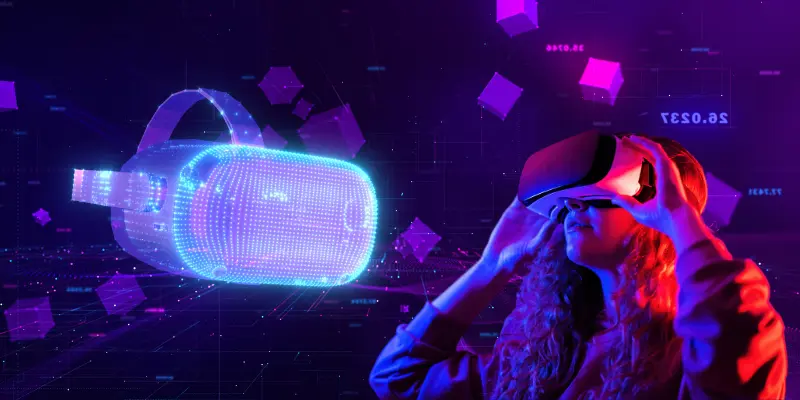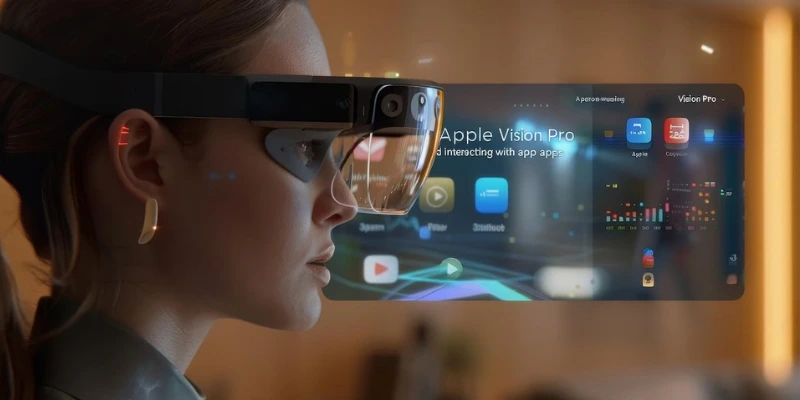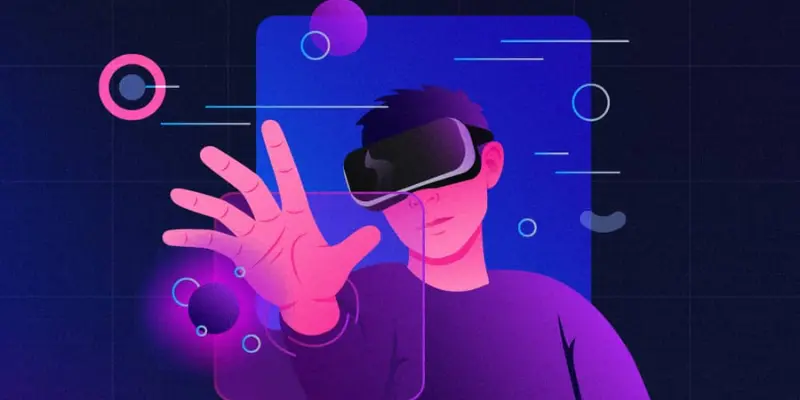The metaverse business is up since technological advances are transforming the metaverse from science fiction to reality. Investors and companies from all over the globe are investing in the metaverse and financing the development of teams, products, and even experiences, creating new possibilities for skilled programmers.
Augmented Virtual Reality (AR) and Virtual Reality (VR) technologies have recently made noise in the technology industry. The latest technologies offer developers numerous options to develop exciting new and exciting experiences. But, with the multitude of languages for programming to choose from, it isn't easy to choose the best language to use for AR VR App Development Services.
In this article, we'll examine the most popular programming languages used by AR and VR creators in 2024.
What Is AR And VR Technology?
Before you can develop ideas and a specific debate on what AR or VR applies to reality, it is essential to keep distinguishing between these two different technologies running in parallel.
Augmented Reality Or AR
Augmented reality provides an immersive virtual experience that simulates the natural world and enhances objects in real life using computer-general data that can be shared across various sensor systems. AR is a way to connect virtual and real worlds, providing live interaction in real-time and precise 3D pictures of real and virtual objects. AR overlays digital information and information into the real world. AR offers new options for devices that can assist you in getting through your hectic day. It provides digital information in the same manner you see your surroundings. AR lets you browse objects visually and just by using your camera.
Virtual Reality Or VR
Virtual reality offers an immersive simulation similar to yet distinct from real-world environments. The headset or multi-projected environment produces authentic sounds, images, and other experiences that increase the user's physical experience within the virtual world. Users can explore and traverse a virtual reality environment while engaging with its elements or objects for optimal solutions. Google Cardboard helps you experience virtual reality in an easy, enjoyable, exciting, and fun way.
Also Read : How Much Does it Cost to Develop an AR VR App?
The Rise Of VR And AR Programming
AR VR App Development Solution have gained much attention recently because of their unique experiences. VR lets users experience a virtual world, while AR overlays digital media onto real-world objects. The scope of the technologies is enormous, and companies are tapping the potential of these technologies to boost user interaction and improve efficiency.
To realize the possibilities to realize their full potential, VR or AR developers have a crucial role to play. The frameworks and programming languages utilized for VR and AR development differ from conventional software development because they require deep knowledge of 3D rendering, modeling, and interaction in real-time
The introduction of VR and AR is opening the door to new opportunities for programmers. These tools allow them to see and interact with codes in new ways and they have proven incredibly helpful. Let's look at how AR and VR are changing the code world.
Visualization Of Code
VR and AR allow programmers to display their code in 3D virtual worlds. It will enable developers to understand the code's structure interactions, dependencies, and structure. Through the visual representation of code, developers can quickly spot design issues or even bottlenecks, making for more efficient and optimized software.
Collaborative Coding
Virtual reality is a great way to collaborate remotely on code projects. Developers could build virtual workspaces instead of traditional video conferences or screen sharing, allowing several programmers to work in real-time. This would help teamwork by enabling developers to share ideas and code fragments and collaborate better. Seamless collaboration is crucial because the world is becoming increasingly interconnected, and remote work has become routine.
Real-Time Testing And Debugging
AR permits real-time testing and debugging of code on the ground. Using AR glasses or smartphone screens, developers can overlay code structures, error messages, or documentation on physical objects. Programmers can quickly identify and correct problems without toggling between screens or testing environments. By streamlining the troubleshooting process, AR saves developers valuable time and speeds up the development process.
What Programming Language Is Used In AR And VR 2024?
The AR and VR business has proliferated in recent years. At first, VR and AR were mainly reserved for the entertainment industry. However, they have expanded to other sectors, including gaming, social networks, medicine and education. Undoubtedly, people in technology see AR and VR as an industry worth exploring.
For AR/VR App Development Company learning the programming languages needed to develop VR and AR platforms. The most important programming languages used in AR and VR development—is one simple prerequisite for entry into this field.
C#
C# can be described as the most reliable development software tool and an industry veteran because it was first introduced in 2000. More modern code languages entice beginners or those who want to become programmers. However, using C# as a C family of languages in your technology stack could have a significant impact, particularly if you're beginning programming for virtual reality platforms and the metaverse in general.
In particular, Unity is one of the most well-known development platforms for VR. It's also important to know that C# is the platform's principal programming language. This is important for those who want to become metaverse designers because Unity has an enormous community. The Unity platform has many users, including independent game developers, enthusiastic hobbyists, and students.
This provides a positive and secure environment for finding the job you want in virtual reality, particularly within the virtual world. For all other reasons, acquiring C# is an additional step toward becoming a better developer, regardless of your future career paths.
JavaScript
JavaScript is primarily used for web-based apps and dynamic website components. It is extensively used and has access to education opportunities because a broad range of free and paid education resources and online communities make it accessible.
JavaScript has quickly become a premier programming language for AR/VR web-based software solutions. If you're creating an electronic product using blockchain technology or creating code for your own virtual reality experiences, such as VR games, JavaScript can be a great option.
JS is now a standard programmers' portfolio. Whether you're looking to build a career in the metaverse or not, knowing JavaScript will likely give you access to the independent development team at big companies in the field of software development. If you want to work in metaphysics, top companies should expect individuals to master JS alongside other languages for coding.
C++
C++ is mainly utilized on an alternative design engine known as Unreal. Unreal is thought to be one of Unity's most formidable opponents. Unreal is a platform for developing AR software that is way too huge for Unity to manage. Many applications fall outside the reach of Unity, and this is where Unreal's application commences.
Unreal is the developer language used to develop apps that run on its platform. The majority of applications can be executed using C++ syntax. These powerful languages offer potent instruments for learning and developing advanced apps. They are mainly used for institutional and business environments. These aspects make C++ a prevalent language to study.
WebGL
WebGL is a JavaScript API used to create 3D images in web browsers. It is extensively used to develop AR and VR experiences that run on the web browser. It is an ideal option for those who wish to create experiences that are easily accessible to an even more comprehensive range of users. All modern browsers can use WebGL, providing developers with various options for creating immersive experiences.
UnityScript
UnityScript is a scripting programming language that is explicitly designed for use in Unity development. The language is a variation of JavaScript. It is extensively used by AR and VR developers because of its ease of use and simplicity. UnityScript permits developers to swiftly and effortlessly develop AR and VR experiences by taking advantage of the numerous features offered within Unity, including motion, physics, and sound effects.
Python
Python was first introduced to software development around thirty years ago and continues to be widely utilized as a general-purpose programming language. Being an open-source programming language means that you are part of a worldwide community of developers, users, and companies who use and contribute to its development. This means it has plenty of help and is secure for the future.
The open-source nature of Python can prove to be a dual-edged sword due to the security concerns associated with an open-source programming language. However, Python is essential for present-day programmers, particularly people keen on creating virtual reality-based applications. Python can also be used to develop augmented reality solutions.
Rust
Blockchain technology is an integral element of the metaverse. If you're considering developing solutions and products for blockchain technology, consider adding Rust to your technology stack. Rust is fast becoming the primary programming language used by the top blockchain platforms, including Solana.
Using Rust as the primary language within the Solana blockchain world means you can take advantage of everything this platform offers, such as NFTs, Web3 games, payment solutions, and more. In simple terms, Rust gives you the tools to create Blockchain-specific applications in the metaverse. It's one of the top language options on your CV. If AR VR App Development Company has Rust on your list, they may be noticed by the blockchain-related teams and organizations that invest in blockchain technology.
Java
Java is a powerful programming language that developers worldwide have widely used. It's now regarded as the primary curriculum for learning object-oriented programming at most schools. Its features that focus on object orientation provide a powerful tool for developing AR components such as neural network algorithms and advanced capabilities for processing languages.
Java is a language with high-end features that meets AR's top-quality requirements. It is a fully integrated 3D Application Processing Interface (API) that lets developers design, analyze, and develop various AR-related elements.
Solidity
Solidity is a programming language specifically developed and endorsed by blockchain technology, such as the Ethereum blockchain. It is a different programming language you should learn to enter involved in the blockchain industry and start programming within the blockchain world. Knowing Solidity can allow you to join a field where investors invest in Ethereum developers and massive projects.
This could be a chance to code for significant innovation in the blockchain field and bring ingenious solutions to the online community. The Ethereum blockchain's smart contract function allows for various applications. Due to the growing demand for blockchains and the endless possibilities in the blockchain, it's clear that integrating Solidity into your programming library is a wise purchase.
The Future Of VR And AR
Virtual and Augmented Reality could be two significant trends in the tech industry. VR is rising within gaming apps and mapping applications, but how will the future unfold for this new technology? How will Virtual Reality impact our everyday lives? Do you think it will become terrifying, or is it just getting too advanced? Let's attempt to dissect this issue straightforwardly.
SLAM, The Future of VR
Simultaneous Mapping and Localization are the most critical issues on the development agenda. They can quickly translate information from the actual world (using sensors) into a virtual reality and vice versa. The TESLA autopilot system uses simultaneous localization and mapping and summons the two main components of the vehicle's tech, which allow the car to analyze its surroundings to avoid crashes. It also comprehends the amount of battery left, and collects many other crucial data elements.
Medical Training
Many universities invest in training their students using Virtual Reality peripherals. One example that comes to mind is obviously medical, whereby putting the trainee in a realistic scenario allows them to be aware of the nuances of the situation without risking the life of anyone (especially when it's used while conducting very delicate surgical procedures). Encouragement of the use of these devices could prove to be a turning point in educating surgeons and experts in procedures and subjects that are typically fragile.
Simulation Is Reaching The Next Level
Flight Simulator, a cult Windows game, recently revealed that a VR-based version is coming later. This version will offer similar experiences to actual pilot training currently provided by various companies. Thus, it is possible to say that the future of these simulations will rely on combined virtual and augmented reality and not exclusively in a video gaming context.
Better Mapping Systems
Undoubtedly, Google has always wanted to discover the VR realm. In the coming years, we can anticipate pairing floor-based AR (the method used to display 3D maps on the Google Maps application) and SLAM technology to provide a realistic representation of the surrounding environment to enhance users' experience. Maps are likely to focus on VR within the next few years, and that's no mystery; it's just a matter of seeing how it will develop within the next few years.
Conclusion
Although various programming languages are used for developing these forums, the single most significant aspect to consider is the fast growth of this industry. The AR and VR sectors have many prospects in the commercial, educational, and medical sectors. VR and AR are rapidly growing in terms of technology since they transport people to fantastic worlds just with a headset. There are no limitations in the kinds of experiences they may offer. With the advancement of technology, companies continue to profit from the potential for profit from VR and AR.
AR and VR programming provide exciting possibilities for developers to create engaging experiences and expand the limits of conventional programming. Due to the growing availability of VR and AR technology, the need for experienced professionals in this field will only grow. Take advantage of this exciting new aspect of programming and let loose your imagination!













Share this blog